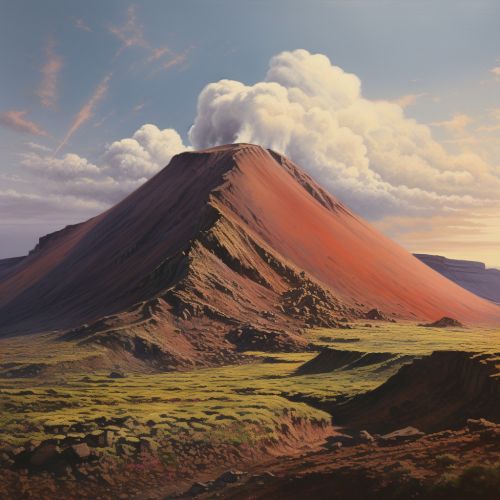Shield Volcano
Introduction
A Shield Volcano is a type of volcano named for its low profile, resembling a warrior's shield lying on the ground. This is caused by the highly fluid (low viscosity) lava erupted, which travels farther than lava erupted from a stratovolcano, and results in the wide, gently sloping shape. These volcanoes are built almost entirely of fluid lava flows. Flow after flow pours out in all directions from a central summit vent, or group of vents, building a broad, gently sloping cone of flat, domical shape, with a profile much like that of a warrior's shield. They are built up slowly by the accretion of thousands of highly fluid lava flows called basalt lava that spread widely over great distances, and then cool as thin, gently dipping sheets. Lavas also commonly erupt from vents along fractures (rift zones) that develop on the flanks of the cone. Some of the largest volcanoes in the world are shield volcanoes.


Formation
The formation of a shield volcano begins when magma from deep within the Earth's mantle rises toward the surface and erupts to form a volcano. The magma that forms shield volcanoes is usually basalt, a type of rock that is very fluid when melted. This fluidity allows the magma to travel a long distance before cooling and hardening, resulting in a wide, broad shield. The eruptions of shield volcanoes are generally not explosive, due to the low viscosity of the magma, which allows gases to escape easily. Instead, the lava pours out in a steady stream, spreading out in all directions. Over time, this lava accumulates, layer upon layer, building up the shield volcano's distinctive shape.
Characteristics
Shield volcanoes are distinguished from the three other major types of volcanoes, stratovolcanoes, lava domes, and cinder cones, by their structural form, a consequence of their particular magmatic composition. Shield volcanoes are built by effusive eruptions, which flow out in all directions to create a shield, hence the name. Shield volcanoes are typically large, broad, and built of layers of lava from repeated non-explosive eruptions.
Examples
Some of the most well-known shield volcanoes are located in Hawaii. The Hawaiian Islands are actually the tops of gigantic shield volcanoes that have formed over a hotspot in the Earth's mantle. Mauna Loa, the world's largest shield volcano, is over 30,000 feet high from its base on the ocean floor to its summit, which is over 13,000 feet above sea level. Other famous shield volcanoes include Kilauea, also in Hawaii, and Galapagos Islands in the Pacific Ocean.
Eruptions
Eruptions at shield volcanoes are only explosive if water somehow gets into the vent, otherwise, they are characterized by low-explosivity fountaining that forms cinder cones and spatter cones at the vent, however, 90% of the volcano is formed from lava flows. Because the lava is so fluid, it can travel long distances and thus create a wide shield volcano. The low viscosity also allows the lava to flood out of the vent and flow down the side of the volcano at a very high rate. This results in a volcano that is very wide and not very tall.
Hazards
While shield volcanoes are not usually associated with violent eruptions, they can still pose hazards to human populations. Lava flows can cause damage to structures and infrastructure, such as roads and buildings. Additionally, the eruption of a shield volcano can release harmful gases into the atmosphere, including sulfur dioxide, which can cause respiratory problems in humans and animals. In some cases, eruptions can also cause tsunamis if they occur under or near the ocean.
Conclusion
In conclusion, shield volcanoes are a fascinating type of volcano that are characterized by their broad, shield-like shape and their non-explosive eruptions. They are formed by the eruption of low-viscosity basaltic magma, which flows out of the volcano and spreads out in all directions. While they are not typically associated with violent eruptions, they can still pose hazards to human populations and the environment.
